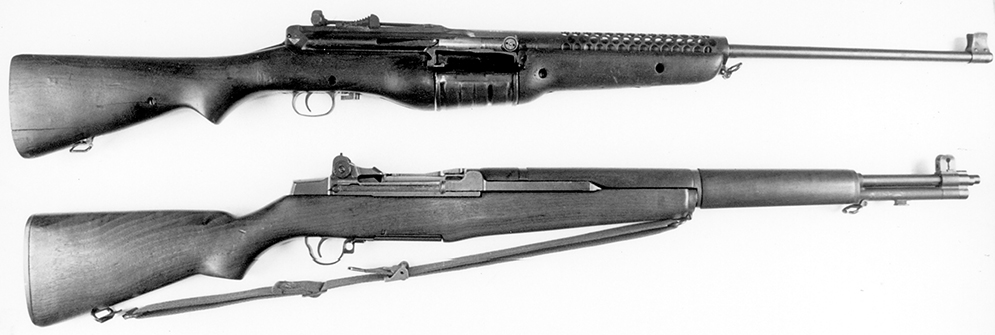The M1941 Johnson Rifle (top) and its rival the M1 Garand.
By Frank Iannamico
There were many factors that contributed to the Allies’ eventual triumph over the Axis powers in WWII. One very important and often overlooked element was the Allie’s ability to develop and manufacture tremendous quantities of weapons. This was especially true for the United States, which had the distinct advantage of having its factories located far from the range of enemy bombers. The United States would become known as the “Arsenal of Democracy” for the amount of weapons supplied to friendly forces for the war effort. One other advantage the United States held was a large pool of designers and engineers. These talented men and women helped the allied forces field some of the best weapons of the war, and just as importantly, in the quantities needed.
Because of its manufacturing and designing capabilities, the United States was able to equip its troops with one of the few successful semi-automatic service rifles of the era, the M1 Garand. In addition to the Garand, the U.S. produced the semi-automatic M1 carbine in even greater numbers. There was a third semi-automatic weapon fielded by the United States, that although it saw very limited use, was believed by many to be superior to the Garand. That weapon was the 30’06 M1941 Johnson Rifle.
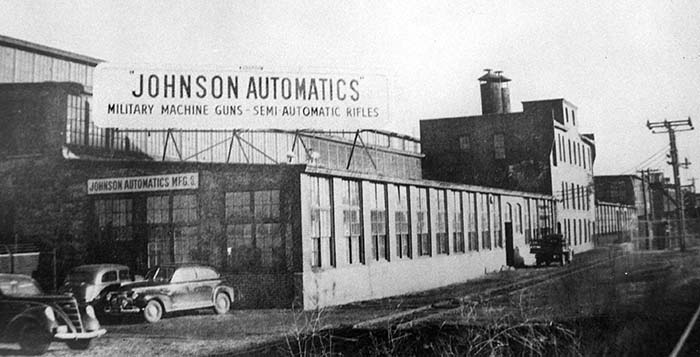
The Johnson rifle was designed by Marine Reserve Captain Melvin M. Johnson Jr., a Harvard educated attorney. Captain Johnson’s idea was “To place in the hands of the individual the maximum power or force which can be easily be operated, controlled and transported by one man one two feet.” Melvin Johnson was assigned to the Springfield Armory as an observer during the development and testing of the M1 rifle. It was during this duty that Captain Johnson saw the problems and shortcomings of the M1 design and difficulties encountered in its manufacture. In 1935 Johnson began work on his own service rifle concept.
Johnson had several prototypes that all shared a similar recoil operated action. In 1937, with assistance from the Marlin Arms Company, Johnson’s design was nearly perfected. A demonstration was given at Fort Benning, Georgia in 1938 to several ordnance officers. The unofficial test was successful enough to warrant further testing at Aberdeen Proving Ground in Maryland. The Aberdeen testing only proved that the Johnson rifle was not superior to the Garand that already was in production.
In 1940 a few minor serviceability problems with the M1 Garand began to surface. These problems quickly became very controversial, especially after the Ordnance Department denied that any problems existed. This controversy gave the Johnson rifle a second opportunity to prove that it was the better weapon. A head to head test was scheduled to compare the Johnson rifle against the Garand. The testing proved that both rifles were capable, but since the M1 Garand was already in production, it would remain the service rifle of the United States Army.
The Johnson design was unique for a major caliber rifle because it was recoil operated. This eliminated the need for a conventional gas system, making the rifle easy to manufacture and less prone to gas fouling. The weapon also featured an integral 10 round rotary magazine that could be easily topped off with additional rounds even while the weapon had a cartridge in the chamber. The magazine could be quickly recharged using the same stripper clips as the M1903 rifle. Some earlier prototypes of the Johnson rifle were designed for a conventional box style magazine. The Garand was handicapped with an eight round enbloc clip that could not be replenished unless the clip was removed from the weapon. In addition, the ejection of the Garand’s 8 round spring steel clip made a rather loud, unique noise signaling to the enemy that the soldier firing the rifle had to reload.
The Johnson however, also had a few undesirable features. One of the characteristics the Ordnance Department didn’t like about the Johnson was it could not mount an effective bayonet, because of the recoiling barrel. Too large of a bayonet interfered with barrel recoil, hampering the weapon’s operation. The second problem was that a bayonet thrust at a target could unlock the action, rendering the weapon momentarily unable to fire. The exposed portion of the barrel also caused some concern. It was feared that an overheated barrel could possibly burn the operator.
The first attempt to address the bayonet problem was by using a long 17-inch sword type bayonet. The .9 pound bayonet was attached to the forearm of the stock. The barrel offered only lateral support, and the barrel moved freely while the bayonet remained stationary. This design was eventually discarded. A small, light bayonet that attached to a lug on the barrel was used. The bayonet was extremely light at .35 pounds and had a triangular 8” blade. The small bayonet allowed the Johnson rifle to function without any problems, and was offered as an accessory.

After several unsuccessful attempts to interest the U.S. military in the Johnson rifle, Johnson’s company began seeking foreign contracts. In 1941 the Netherlands ordered 70,000 of the M1941 Johnson semi-auto rifles for the Dutch East Indies Defense Force. In order to fill such a large order a new manufacturing facility would be needed. The Johnson Automatics Company subcontracted with the Universal Windings Company to manufacture the weapons at their factory complex located in Cranston, Rhode Island. The company would be known as the Cranston Arms Company. Soon after the weapons were in mass production the Japanese overran the Dutch East Indies and the order was terminated. It is believed that only 30,000 Johnsons were manufactured before production ceased in early 1943. The only other sizable foreign order for the M1941 rifle was from Chile in the early 1940s. A small lot of 1,000 rifles were purchased. Chile ordered the rifles chambered for the 7mm Mauser cartridge. A subcontractor in Mexico manufactured the 7mm barrels for Cranston Arms Co.
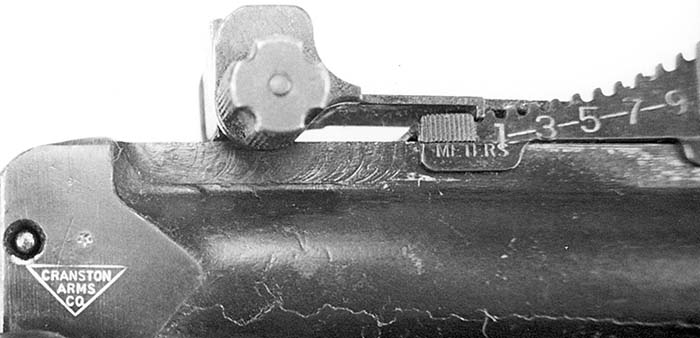
The Marine Corps had begun testing semi-automatic rifles in late 1940. Although the Marines had also chosen the M1 Garand over the Johnson rifle in 1941, few M1s were available as demand far exceeded the supply. This caused the Marine Corps to take a second look at the Johnson. One feature that the Marines liked about the Johnson was that the weapon could be easily broken down for transporting. The Marines felt that this would be an asset for their newly formed paratrooper battalions where the rifles could be easily carried when disassembled. The Marines procured a limited number of the Johnson rifle for issue to the 1st Parachute Battalion in 1942. It is believed that the Johnson rifles obtained by the Marine Corps were those remaining from the canceled Dutch contract. The Johnson rifles used by the Paramarines can sometimes be identified by the front sight protection ears, which were often filed down. The purpose was to create a better sight picture, and keep the long sight ears from snagging on their jump cases.
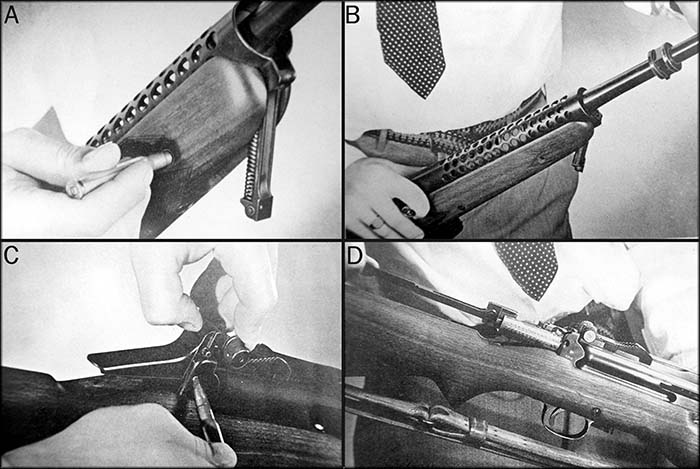
A few years after the war ended, the Winfield Arms Company of Canada purchased all of the embargoed Dutch contract guns. Most of the remaining Johnson spare parts were purchased by Numrich Arms (Gun Parts Corporation.). Many of these parts were eventually purchased by Winfield Arms and used to build or repair the rifles obtained from the Dutch contract. The company sporterized many of the Johnsons and sold them as hunting rifles. They were offered in several configurations that included the original 30’06, as well as 7mm and .270 calibers.
The semi-automatic Johnson rifles today have far surpassed the average M1 Garand in price. An original military configuration Johnson rifle today is a highly prized collector’s item. All of the military Johnsons had a Parkerized finish, except for the bolt, which was left in the white. The aperture style rear sight is adjustable and graduated in meters. There are no military or U.S. Ordnance markings to distinguish a Marine Corps issued rifle. All the weapons are marked on the right side of the receiver “ Cranston Arms Co.” inside of an inverted triangle, and “Johnson Automatics Model of 1941” on top of the receiver. The first block of serial numbers of the rifles ascends up to 9,999. Subsequent number blocks begin with a letter A or B prefix. As previously mentioned, it is believed that fewer than 30,000 of the rifles were made. Although many of the parts on the M1941 Johnson rifles are numbered, an “all matching rifle” is quite a rarity. Original Johnson bayonets and leather sheaths are especially rare, as are original manuals. Both items command a premium when they can be located.
The recoil action of the Johnson is a very interesting design. When the weapon is fired, the barrel moves rearward approximately one-half inch. The barrel is supported only by the receiver. A rotary bolt moves rearward, locked to the barrel until it is unlocked by being rotated 20 degrees by a camming action between the receiver and bolt. The barrel’s rearward movement is stopped by a shoulder in the receiver, while the bolt continues rearward far enough to pick up a fresh round from the magazine before being pushed forward by the recoil spring. The rotating bolt head is locked to the barrel by eight lugs. The recoil spring and buffer are located in the stock.
There was also a Model 1941 and a Model 1944 Johnson light machine gun produced, which featured a similar recoil operated action. The Marine Corps used the magazine fed weapon in limited numbers during WWII. The weapon had a few advantages over the BAR, it was lighter and the barrel could be easily replaced in the field. An improved model, the 1944 LMG, was later introduced and manufactured in limited numbers. Special thanks to Jim Pullen. Jim has an excellent web site on the Johnson Rifle at www.johnsonautomatics.com.
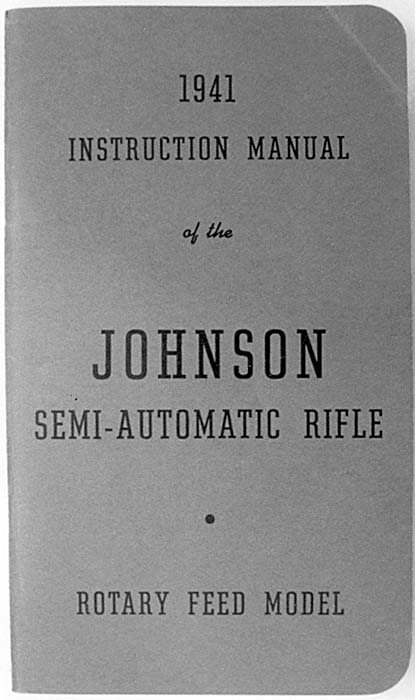
Next: The Johnson Light Machine Guns…
| This article first appeared in Small Arms Review V4N6 (March 2001) |



